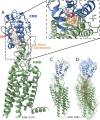The Intimate Connection Between Lipids and Hedgehog Signaling
- PMID: 35757007
- PMCID: PMC9222137
- DOI: 10.3389/fcell.2022.876815
The Intimate Connection Between Lipids and Hedgehog Signaling
Abstract
Hedgehog (HH) signaling is an intercellular communication pathway involved in directing the development and homeostasis of metazoans. HH signaling depends on lipids that covalently modify HH proteins and participate in signal transduction downstream. In many animals, the HH pathway requires the primary cilium, an organelle with a specialized protein and lipid composition. Here, we review the intimate connection between HH signaling and lipids. We highlight how lipids in the primary cilium can create a specialized microenvironment to facilitate signaling, and how HH and components of the HH signal transduction pathway use lipids to communicate between cells.
Keywords: cholesterolyation; cilia; development; intercellular signaling; sterols.
Copyright © 2022 Nguyen, Truong and Reiter.
Conflict of interest statement
The authors declare that the research was conducted in the absence of any commercial or financial relationships that could be construed as a potential conflict of interest.
Figures



Similar articles
-
The contrasting roles of primary cilia and cytonemes in Hh signaling.Dev Biol. 2014 Oct 1;394(1):1-5. doi: 10.1016/j.ydbio.2014.07.015. Epub 2014 Jul 27. Dev Biol. 2014. PMID: 25072627 Free PMC article.
-
Transient Primary Cilia Mediate Robust Hedgehog Pathway-Dependent Cell Cycle Control.Curr Biol. 2020 Jul 20;30(14):2829-2835.e5. doi: 10.1016/j.cub.2020.05.004. Epub 2020 Jun 11. Curr Biol. 2020. PMID: 32531277 Free PMC article.
-
Control of the Hedgehog pathway by compartmentalized PKA in the primary cilium.Sci China Life Sci. 2022 Mar;65(3):500-514. doi: 10.1007/s11427-021-1975-9. Epub 2021 Sep 7. Sci China Life Sci. 2022. PMID: 34505970 Free PMC article. Review.
-
The Inseparable Relationship Between Cholesterol and Hedgehog Signaling.Annu Rev Biochem. 2023 Jun 20;92:273-298. doi: 10.1146/annurev-biochem-052521-040313. Epub 2023 Mar 31. Annu Rev Biochem. 2023. PMID: 37001135 Free PMC article. Review.
-
Hedgehog signaling from the primary cilium to the nucleus: an emerging picture of ciliary localization, trafficking and transduction.Curr Opin Genet Dev. 2013 Aug;23(4):429-37. doi: 10.1016/j.gde.2013.04.008. Epub 2013 May 29. Curr Opin Genet Dev. 2013. PMID: 23725801 Free PMC article. Review.
Cited by
-
Primary cilia as dynamic and diverse signalling hubs in development and disease.Nat Rev Genet. 2023 Jul;24(7):421-441. doi: 10.1038/s41576-023-00587-9. Epub 2023 Apr 18. Nat Rev Genet. 2023. PMID: 37072495 Free PMC article. Review.
-
Parkinsonism Sac domain mutation in Synaptojanin-1 affects ciliary properties in iPSC-derived dopaminergic neurons.bioRxiv [Preprint]. 2023 Oct 13:2023.10.12.562142. doi: 10.1101/2023.10.12.562142. bioRxiv. 2023. Update in: Proc Natl Acad Sci U S A. 2024 Apr 23;121(17):e2318943121. doi: 10.1073/pnas.2318943121. PMID: 37873399 Free PMC article. Updated. Preprint.
-
Seriously cilia: A tiny organelle illuminates evolution, disease, and intercellular communication.Dev Cell. 2023 Aug 7;58(15):1333-1349. doi: 10.1016/j.devcel.2023.06.013. Epub 2023 Jul 24. Dev Cell. 2023. PMID: 37490910 Free PMC article. Review.
-
Gotta Go Slow: Two Evolutionarily Distinct Annelids Retain a Common Hedgehog Pathway Composition, Outlining Its Pan-Bilaterian Core.Int J Mol Sci. 2022 Nov 18;23(22):14312. doi: 10.3390/ijms232214312. Int J Mol Sci. 2022. PMID: 36430788 Free PMC article.
-
Sonic hedgehog signaling in craniofacial development.Differentiation. 2023 Sep-Oct;133:60-76. doi: 10.1016/j.diff.2023.07.002. Epub 2023 Jul 13. Differentiation. 2023. PMID: 37481904 Free PMC article. Review.
References
-
- Amanai K., Jiang J. (2001). Distinct Roles of Central Missing and Dispatched in Sending the Hedgehog Signal. Development 128, 5119–5127. 10.1242/dev.128.24.5119 PubMed Abstract | 10.1242/dev.128.24.5119 | Google Scholar - DOI - DOI - PubMed
-
- Andrews D., Nelson D. L. (1979). Biochemical Studies of the Excitable Membrane of Paramecium Tetraurelia. II. Phospholipids of Ciliary and Other Membranes. Biochimica Biophysica Acta (BBA) - Biomembr. 550, 174–187. 10.1016/0005-2736(79)90205-0 PubMed Abstract | 10.1016/0005-2736(79)90205-0 | Google Scholar - DOI - DOI - PubMed
-
- Babin P. J., Bogerd J., Kooiman F. P., van Marrewijk W. J. A., van der Horst D. J. (1999). Apolipophorin II/I, Apolipoprotein B, Vitellogenin, and Microsomal Triglyceride Transfer Protein Genes Are Derived from a Common Ancestor. J. Mol. Evol. 49, 150–160. 10.1007/PL00006528 PubMed Abstract | 10.1007/PL00006528 | Google Scholar - DOI - DOI - PubMed
-
- Bachmann V. A., Mayrhofer J. E., Ilouz R., Tschaikner P., Raffeiner P., Röck R., et al. (2016). Gpr161 Anchoring of PKA Consolidates GPCR and cAMP Signaling. Proc. Natl. Acad. Sci. U.S.A. 113, 7786–7791. 10.1073/pnas.1608061113 PubMed Abstract | 10.1073/pnas.1608061113 | Google Scholar - DOI - DOI - PMC - PubMed
-
- Balla T., Várnai P. (2002). Visualizing Cellular Phosphoinositide Pools with GFP-Fused Protein-Modules. Sci. STKE 2002. pl3–pl3. 10.1126/STKE.2002.125.PL3 PubMed Abstract | 10.1126/STKE.2002.125.PL3 | Google Scholar - DOI - DOI - PubMed

